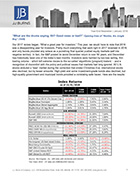“It’s time to move on, time to get going / What lies ahead, I have no way of knowing” Tom Petty & The Heartbreakers, “Time to Move On”
What a difference a year makes. Our first-quarter missive last year focused on the uncertainty in our lives due to the global COVID pandemic. The future was murky, a ‘known unknown.’ Markets careened wildly during that quarter, and investors fell in behind one of the Four Horsemen of the Investing Apocalypse, Hope. Equity markets have since rewarded investors with strong returns, and bonds (until recently) did as well. What we see in this year’s Q1 returns is another of the Horsemen joining the herd, Fear. The fear isn’t necessarily related to a virus, however; it’s focused on something intangible – inflation.
Most investors believe that their benchmark is a market index (e.g. the S&P 500). They miss the point that the wealth-creation endeavor is designed to provide for levels of asset growth and subsequent drawdown that exceed the required payments of expenses, taxes and inflation. Wage and price inflation are necessary components of growth, but rather than focus on the expected post-vax resurgence, markets switched focus from one ‘invisible’ enemy, the COVID-19 virus, to another: expected inflation.
Regardless of which horse one tends to follow, the ‘risk-on’ horse joined the herd and rewarded equity investors with strong Q1-21 returns, especially in U.S. small-cap and value stocks. Non-U.S. stocks also performed well, as did U.S. REITs. Bonds, except for U.S. high-yield issues, suffered as the bond market reacted to inflation fears and expectations of future Fed actions, specifically interest-rate increases.
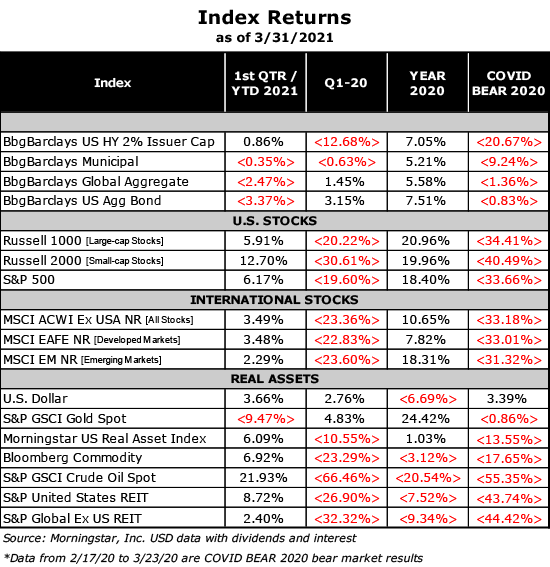
“As you discover changing times / It’s not so bad as you will find” Earth, Wind & Fire, “Changing Times”
What’s confusing about the current market environment is the belief that things investors should see as market tailwinds are, in fact, considered headwinds. Recall the environment a year ago: severe economic shutdown, confined to our homes, consumed by fear of the unknown. Now think about where we are today. We have multiple vaccines and more knowledge about the virus; the U.S. recently passed $3 trillion in COVID bailout legislation that’s expected to fuel a ‘reopening wave’; unemployment is falling, and the Fed stepped in to support the markets with massive stimulus last year. Expectations for economic growth and earnings were too dire last year and have turned quite optimistic this year. All these actions have promoted optimism for a massive growth-and-spending surge. And yet…inflation fears have returned because investors assume this combined consumer-and-federal stimulus spending, on par with the spending during World War II, will lead to systemically higher prices and higher wages. Markets don’tappear willing to trust that the Fed will be able to maintain low interest rates in pursuit of higher inflation (above 2%) and ‘full’ employment (an unemployment level around 4%), and have pushed up Treasury-bond yields:
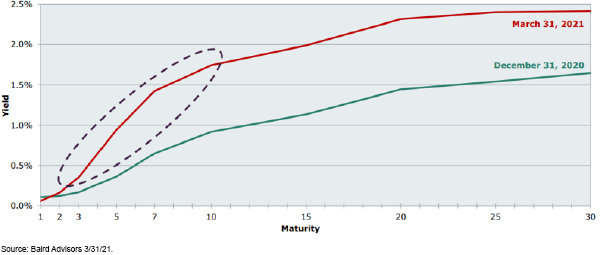
Treasury yields have risen along the curve as investors expect the Fed will raise rates sooner than they would like due to higher inflation readings and possible wage pressures. Bonds had one of their worst quarters in decades in Q1, creating opportunities for investors (dotted area).
We expect near-term inflation to tick up, partly due to oil’s recovery and partly due to comparisons to 2020. Repositioning the global supply chain, a longer-term U.S. goal, will also affect inflation, but will take time and the effects are extremely difficult to predict. The markets are pricing in interest-rate moves sooner than the Fed has indicated in the expectation that the Fed will have to sacrifice its unemployment mandate to control prices. This thinking ignores recent history, when the markets and the Fed worried about deflation, or falling prices. It also ignores the fact that inflation has been tame for long stretches since the oil-shock years of the 1970s, and core CPI has been under 3% for over a decade:
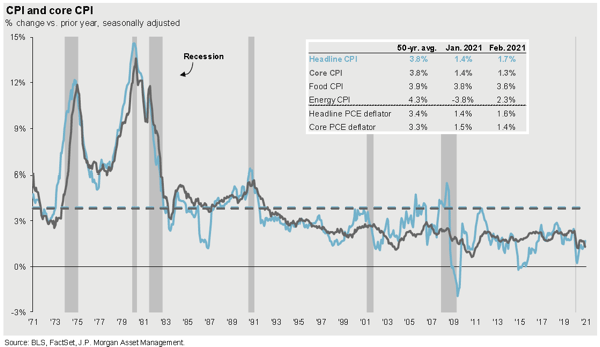
Consumer inflation has trended at or below 4% since the early 1990s. Tepid wage growth, technology advancements, an expanding global economy and a robust global supply chain all contributed to this benign period of price expansion. It should be noted that housing is not included in these data, but rent payments are. We can also see that there are periods of inflation flares, but not enough to cause the pain felt in the 1970s.
“Can’t take it with you when you’re gone / But I want enough to get there on / And I ain’t ever growin’ old / So, I keep on rollin’ with the flow” Charlie Rich, “Rollin’ With The Flow”
Investors are flagrant opportunists, so despite fears of rising inflation and interest rates, 1st quarter 2021 returns saw a rotation away from the market’s growth darlings to cyclical names that should benefit from the pent-up demand and sidelined spending to come.
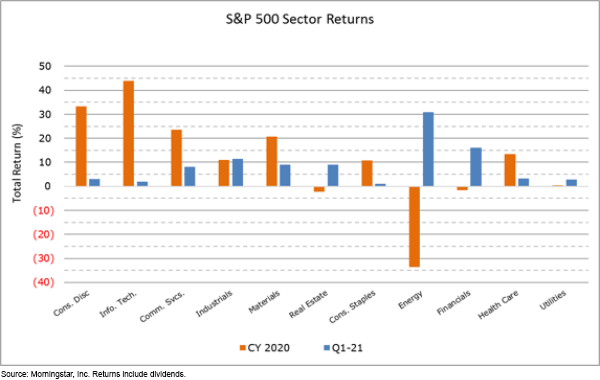
We can see that classic cyclical value sectors – financials, utilities, energy – are doing quite well compared to 2020 (orange data) and growth sectors thus far in 2021 (blue data). Other sectors that are tied to growth – materials, industrials, real estate – are also doing well thus far and are ahead of growth sectors. Note that the leisure and hospitality industries are considered discretionary stocks, and staples are names such as Clorox and Proctor & Gamble.
We can also see where the effects of strong Q4-20 earnings, movement on the Biden stimulus package and growing vaccination distribution shifted expectations away from favored growth investments to unloved domestic value names in the some of the industries detailed listed (red line below):
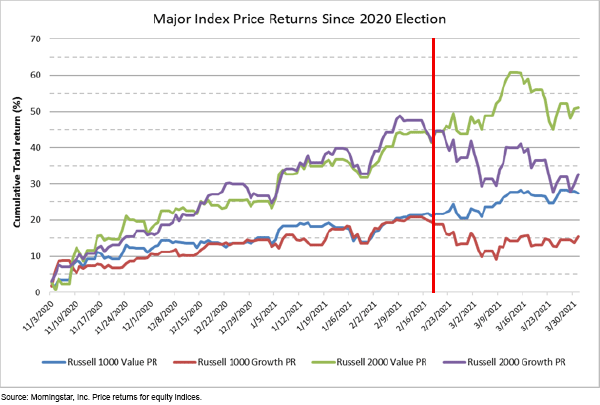
Growth stocks are sensitive to changes in interest rates and, like some bonds, are also considered a ‘long duration’ asset. We can also see that U.S. small-cap stocks (Russell 2000) have outperformed their large-cap (Russell 1000) counterparts since the election, and value stocks have begun to separate from growth names.
While this rotation is welcome, it does not imply that the technology ‘revolution’ we’re experiencing is over, or that stocks of any type will avoid corrections.
“There’s some hard times in the neighborhood / But why can’t every day be just this good” Travis Tritt, “It’s a Great Day to Be Alive”
We’re still convinced that the jobs recovery from last year’s recession and widespread vaccinations are the two keys to a sustained global recovery from the forgettable year of 2020. Global growth will still recover, if unevenly, and stocks should do well. There will continue to be some issues with bonds.
It seems premature to worry too much about inflation, as past evidence indicates that rash wage and price hikes create the inflation we seek to avoid. Finally, there is still much we don’t know about the virus and its variants, and the usual geopolitical issues (e.g. managing relations with China, income inequality) are still present. We expect higher volatility going forward in 2021, as last year’s hope rally seemed ahead of itself and will eventually meet reality. We expect our rebalancing efforts will be to move assets from stocks to replenish fixed-income allocations after the bond sales we executed to buy stocks during 2020.
We anticipate the reopening of the economy to be uneven due to supply-chain disruptions. The markets are anticipating good news and there will certainly be disappointments as we move through the year. That said, there appears to be quite a bit of pent-up consumer demand that should sustain the economy moving forward as we hopefully put the worst of the pandemic behind us.
As always, please take time to review your financial plan and portfolio(s) and contact us with your comments and questions.
—Your Wealth Management Team at JJ Burns & Company
Download Market Commentary
Disclosure: J.J. Burns & Company, LLC is a registered investment adviser with the U.S. Securities & Exchange Commission and maintains notice filings with the States of New York, Florida Pennsylvania, New Jersey, Connecticut, Georgia, Illinois, North Carolina, and California. J.J. Burns & Company, LLC only transacts business in states where it is properly registered, or excluded or exempted from registration. Follow-up and individualized responses to persons that involves either the effecting or attempting to effect transactions in securities, or the rendering of personalized investment advice for compensation, as the case may be, will not be made absent compliance with state investment adviser and investment adviser representative registration requirements, or an applicable exemption or exclusion.
All investing involves risk, including the potential for loss of principal. There is no guarantee that any investment plan or strategy will be successful.
The foregoing content reflects the opinions of J.J. Burns & Company, LLC and is subject to change at any time without notice. Content provided herein is for informational purposes only and should not be used or construed as investment advice or a recommendation regarding the purchase or sale of any security. There is no guarantee that the statements, opinions or forecasts provided herein will prove to be correct.
Past performance may not be indicative of future results. Indices are not available for direct investment. Any investor who attempts to mimic the performance of an index would incur fees and expenses which would reduce returns.
Securities investing involves risk, including the potential for loss of principal. There is no assurance that any investment plan or strategy will be successful.


